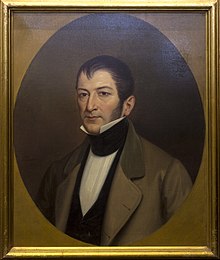Nicolás Bravo
This article includes a list of general references, but it remains largely unverified because it lacks sufficient corresponding inline citations. (March 2009) |
Nicolás Bravo Rueda | |
|---|---|
 | |
| 11th President of Mexico | |
| In office 10 July 1839 – 19 July 1839 | |
| Preceded by | Antonio López de Santa Anna |
| Succeeded by | Anastasio Bustamante |
| In office 26 October 1842 – 4 March 1843 | |
| Preceded by | Antonio López de Santa Anna |
| Succeeded by | Antonio López de Santa Anna |
| In office 28 July 1846 – 4 August 1846 | |
| Vice President | Himself |
| Preceded by | Mariano Paredes |
| Succeeded by | José Mariano Salas |
| Vocal of the Regence of the Mexican Empire | |
| In office 11 April 1822 – 18 May 1822 | |
1st Vice President of United Mexican States | |
| In office 10 October 1824 – 23 December 1827 | |
| President | Guadalupe Victoria |
| Succeeded by | Anastasio Bustamante |
4th Vice President of Mexican Republic | |
| In office 12 June 1846 – 6 August 1846 | |
| President | Mariano Paredes Himself |
| Preceded by | Antonio Lopez de Santa Anna |
| Succeeded by | Valentín Gómez Farías |
| Personal details | |
| Born | 10 September 1786 Chichihualco, Guerrero, New Spain |
| Died | 22 April 1854 (aged 67) Chilpancingo, Guerrero (now Mexico) |
| Political party | Centralist |
Nicolás Bravo Rueda (10 September 1786 – 22 April 1854) was the 11th President of Mexico and a soldier. He distinguished himself in both roles during the 1846–1848 U.S. invasion of Mexico.
Army career[]
During the Mexican War of Independence (1810-1821), Bravo fought alongside Hermenegildo Galeana and then José María Morelos in the campaign of the south. In 1811, with Hermenegildo Galeana, Bravo obtained the military command of the province of Veracruz. He was also involved in the defense of the Congress of Chilpancingo.
In 1817, the royalists took him prisoner and it was only in 1820 that he recovered his freedom. He allied himself with the Plan de Iguala, and on 27 September 1821, he entered Mexico City with the triumphant Ejército Trigarante (in the "Army of the Three Guarantees").
Political career[]

When independence was attained, he was named advisor of state by the Constituent Congress.
When Agustín de Iturbide was crowned emperor, he took up arms in opposition and formed a governing body in Oaxaca City. Bravo created an army and marched on Mexico City via Puebla. When Iturbide was overthrown, Bravo, Guadalupe Victoria, and Pedro Celestino Negrete governed the country until in 1824 there were elections. Bravo lost the elections and of vice presidency under the presidency of Guadalupe Victoria (1824–27).
Political parties had not yet formed, and country's the political elites were associated with two Masonic lodges, the centrist Scottish Rite (los escoseses) and the somewhat more liberal York Rite (los yorquinos). Bravo was the grand master of the Scottish Rite lodge between 1823 and 1827, and the lodge had captured most positions of political influence in the country. Over the course of 1827, however, the opposing York Rite began to gain swiftly in power and influence. Fearing that his side would lose its privileged position, Bravo led a military insurrection (known variously as the Revolution of Tulancingo, after the central Mexican town in which it was centered, or the Revolt of Montaño, after a minor political figure who nominally headed it) against the York-controlled federal army. The rebellion was a fiasco; launched on 23 December 1827, it attracted only a few hundred rebels and fell apart after Bravo was captured on 7 January 1828. Despite calls for his execution, Bravo was exiled to Ecuador. He returned to Mexico in 1829 after a change in national government.
He occupied several governmental positions. In 1842 to 1843, he served as president of Mexico for a little over four months; he also served as president in 1839 and 1846 (the latter as vice president), for short periods.
During the Mexican–American War, he fought against the United States at Castillo de Chapultepec. At the Battle of Chapultepec on 13 September 1847, he was made prisoner.
Death[]

Bravo died in his hacienda at Chichihualco, Guerrero, on 22 April 1854 at the same time as his wife, which caused a rumor that they had been poisoned.
See also[]
References[]
- Zárate, Julio (1880), «La Guerra de Independencia», en Vicente Riva Palacio, México a través de los siglos, III volumen, México: Ballescá y compañía, consultado en 6 de mayo de 2012.
- http://www.inep.org/index2.php?option=com_content&do_pdf=1&id=215
- Presidents of Mexico
- Vice presidents of Mexico
- Mexican military personnel of the Mexican–American War
- People of the Mexican War of Independence
- Mexican generals
- 1786 births
- 1854 deaths
- 19th-century Mexican people
- 1840s in Mexico
- Politicians from Guerrero
- Military personnel from Guerrero
- People from Chilpancingo
- Governors of Puebla
- Candidates in the 1824 Mexican presidential election
- Mexican prisoners of war
- Mexican–American War prisoners of war held by the United States
- 19th-century Mexican military personnel
